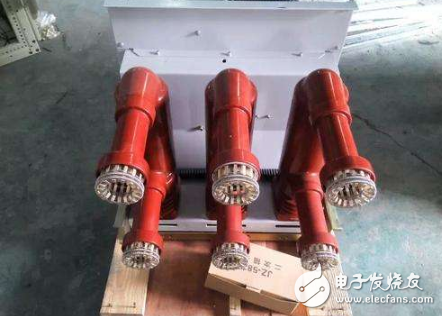This paper begins by examining common faults that occur during the operation of vacuum circuit breakers, conducting a detailed analysis of these issues and offering practical solutions. The goal is to enhance users' technical knowledge and improve their ability to handle such equipment effectively.
Vacuum circuit breakers are widely used in high-voltage applications due to their numerous advantages. Unlike traditional oil-filled breakers, they are oil-free, have a long electrical and mechanical life, excellent insulation properties, and can withstand repeated operations without significant degradation. They are compact, lightweight, and require minimal maintenance, making them ideal for power system applications. Since the early stages of their development, however, some models suffered from quality inconsistencies, including high current-carrying voltages and air leakage in vacuum interrupters. By 1992, at the Tianjin Vacuum Switch Application Promotion Conference, China had made significant progress in vacuum circuit breaker technology, placing it among the global leaders in this field. As their usage expanded, so did the occurrence of various operational faults.

**First, common operational failures of vacuum circuit breakers**
1. **Circuit breaker rejection or failure to operate**
This occurs when the circuit breaker fails to close or open after receiving the command. The electromagnet and spring may function correctly, but the arc extinguishing chamber does not respond properly.
2. **Unintended tripping**
The circuit breaker trips unexpectedly under normal operating conditions, often due to internal faults or miswiring.
3. **Energy storage motor continues running**
After the mechanism has stored energy, the motor keeps running instead of stopping as expected.
4. **Increased DC resistance**
Over time, the contact resistance in the arc chamber increases, which can affect performance and lead to overheating.
5. **Increased closing bounce time**
The contacts bounce more during closing, which may cause damage over time if not addressed.
6. **Surface discharge from CT to bracket**
The current transformer (CT) surface discharges to the intermediate box bracket, often due to improper insulation or moisture exposure.
7. **Failure to disconnect**
After an opening command, the circuit breaker does not fully or properly disconnect, which can be dangerous.
**Second, causes of the failures**
1. **Refusal to trip or close**
This is often due to mechanical misalignment or secondary circuit issues. For example, a worn universal joint may prevent the breaker from operating correctly.
2. **Unintended tripping**
A short circuit in the auxiliary switch can trigger false tripping, especially if water enters the mechanism box.
3. **Motor running continuously**
If the travel switch fails to cut off the power, the motor will keep running even after the spring is fully charged.
4. **Increasing DC resistance**
Contact wear and reduced spring pressure can increase resistance, affecting the breaker’s performance.
5. **Bounce time increase**
Spring fatigue or mechanical wear can cause longer bounce times, increasing the risk of contact damage.
6. **Surface discharge from CT**
Poor insulation or damage to semiconductor coatings on the CT can lead to discharge between the CT and the bracket.
7. **Failure to disconnect**
Low vacuum levels in the interrupter can reduce insulation, preventing the breaker from breaking the circuit properly.
**Third, solutions to the problems**
1. **Refusal to trip or close**
Check all mechanical linkages and replace any worn or damaged parts with high-quality replacements.
2. **Unintended tripping**
Seal all potential entry points for moisture, install sealing sleeves, and ensure proper ventilation inside the mechanism box.
3. **Motor running continuously**
Adjust the travel switch so that it cuts off the power when the spring is fully charged.
4. **Increased DC resistance**
Adjust the contact gap and overtravel, and use a DC voltage drop method to measure resistance. Replace the arc chamber if necessary.
5. **Increased closing bounce**
Increase spring pressure, replace worn components, and adjust the transmission mechanism to minimize bounce.
6. **Surface discharge from CT**
Apply a uniform layer of semiconductor glue to the CT surface to eliminate uneven electric fields.
7. **Failure to disconnect**
If the vacuum level is too low, replace the interrupter. Ensure the new one passes a vacuum test before installation, and carefully align the moving rod and arc chamber to avoid torque during operation.
By addressing these common issues, operators can significantly improve the reliability and safety of vacuum circuit breakers, ensuring smooth and efficient power system operations.
Mining Light Tower
A mining light tower is a tall structure equipped with powerful floodlights that are used to illuminate large areas in mining operations. These towers are typically portable and can be easily moved around the mining site as needed.
The main purpose of a mining light tower is to provide sufficient lighting for workers to safely carry out their tasks during nighttime or in areas with low visibility. This is particularly important in underground mines where natural light is limited or absent.
Mining light towers are usually powered by diesel generators or other portable power sources. They are designed to withstand harsh mining environments, including extreme temperatures, dust, and vibrations.
The height of the light tower allows for a wide coverage area, ensuring that the entire mining site is well-lit. The floodlights used in these towers are high-intensity discharge (HID) lamps or light-emitting diodes (LEDs) that can produce a bright and focused light beam.
In addition to providing illumination, some mining light towers may also have features such as telescopic masts, adjustable light angles, and remote control operation for enhanced convenience and flexibility.
Overall, mining light towers play a crucial role in ensuring the safety and productivity of mining operations by providing adequate lighting in challenging work environments.
Mining Light Tower,Industrial Mobile Lighting Tower,Diesel Engine Lighting Tower,Hydraulic Mast Light Tower
Grandwatt Electric Corp. , https://www.grandwattelectric.com
